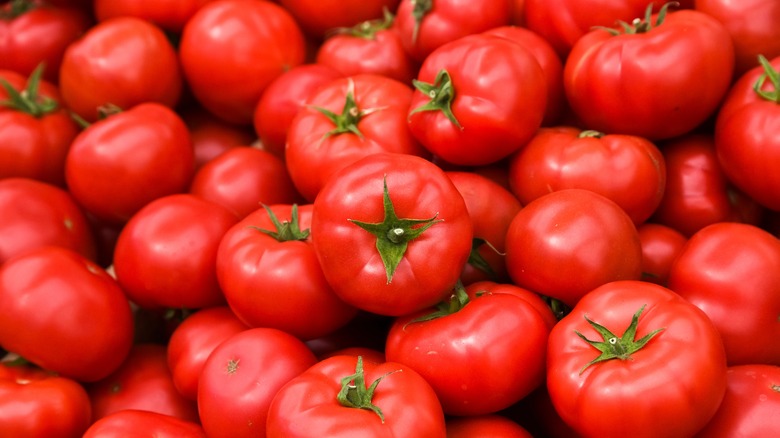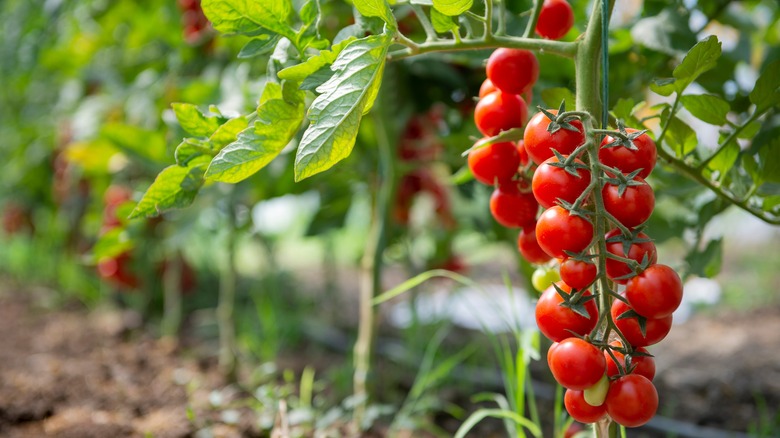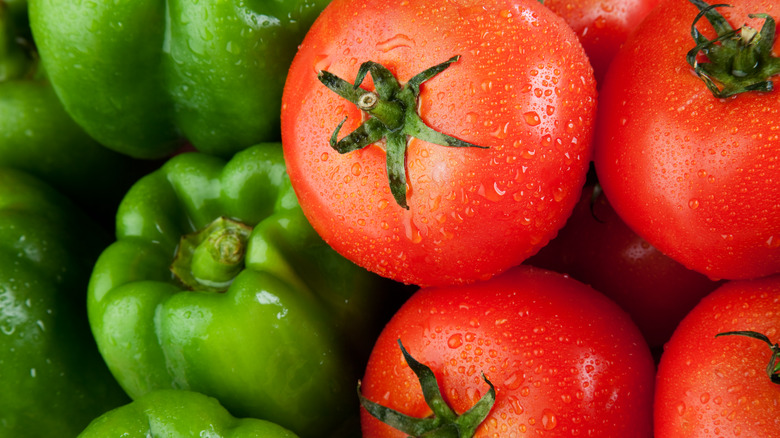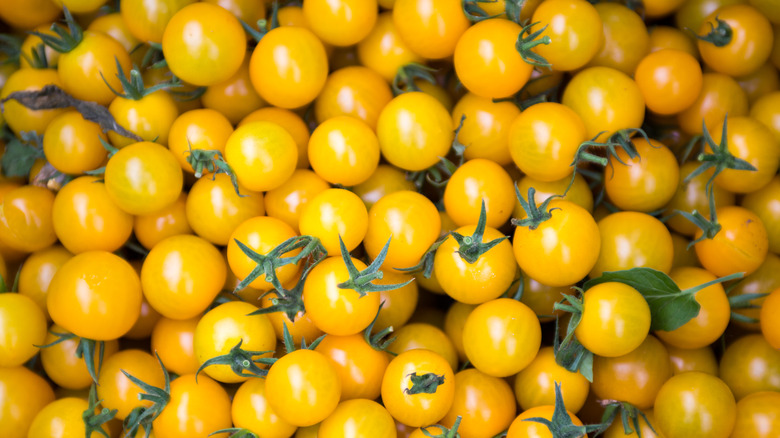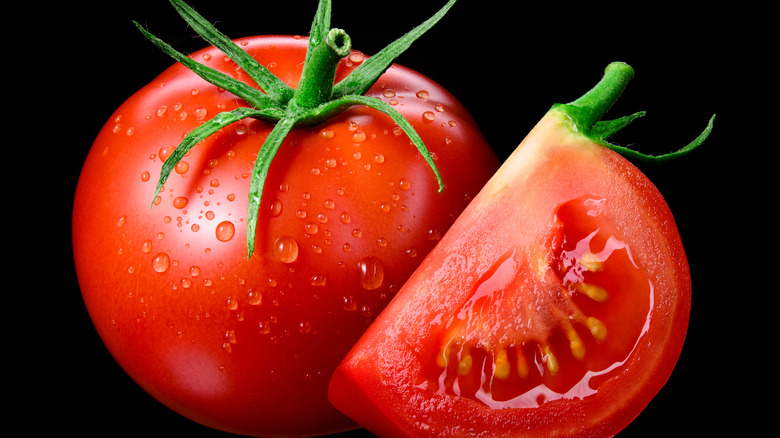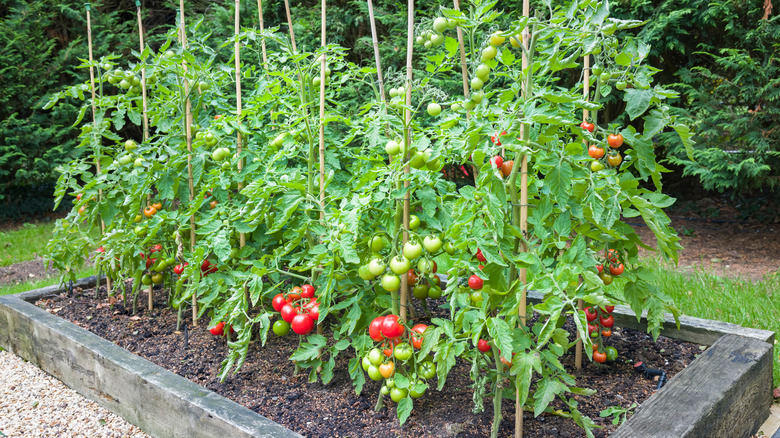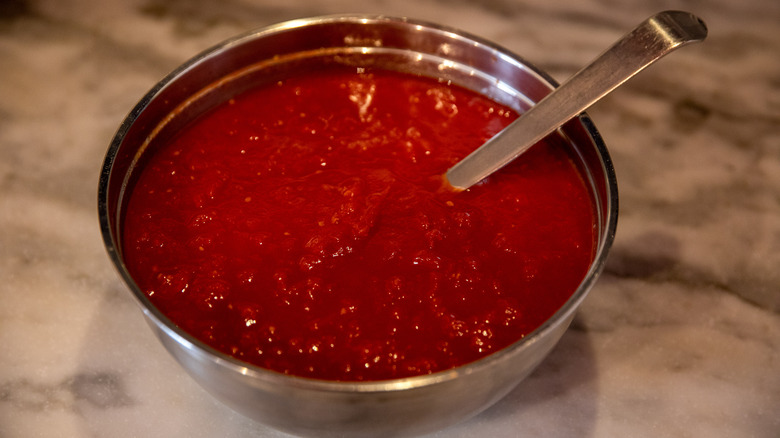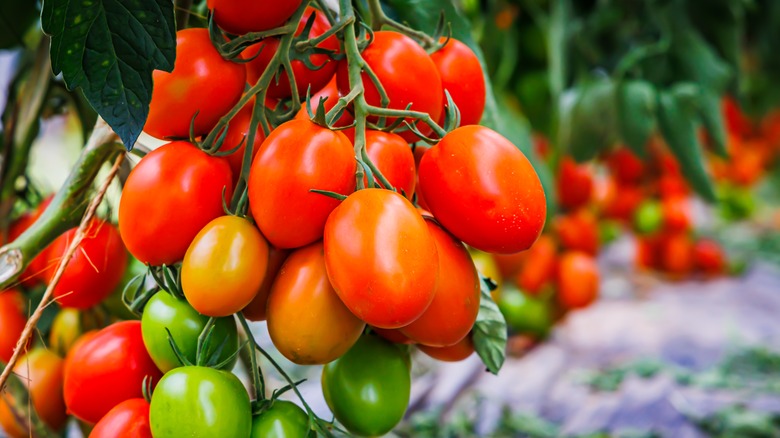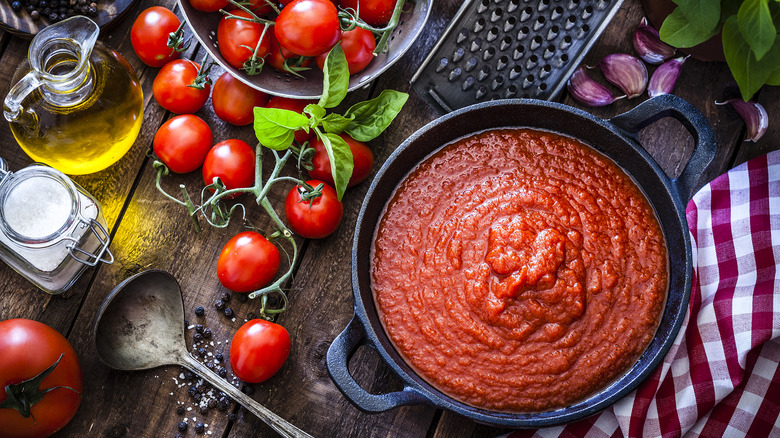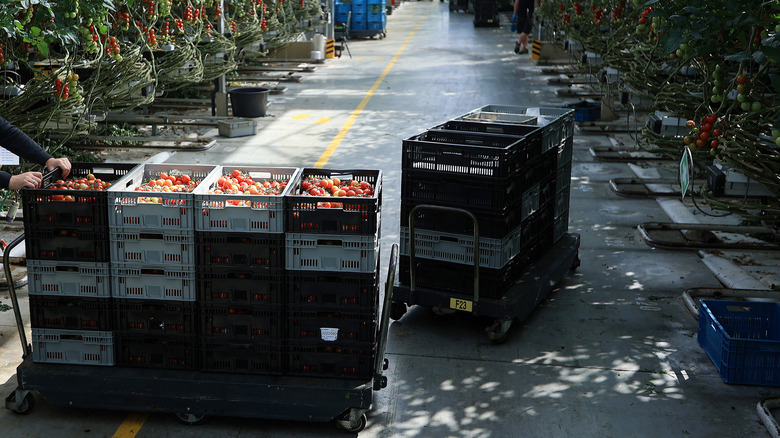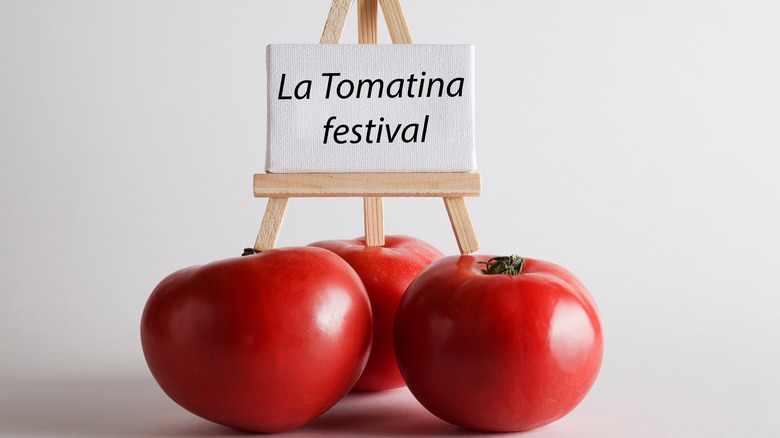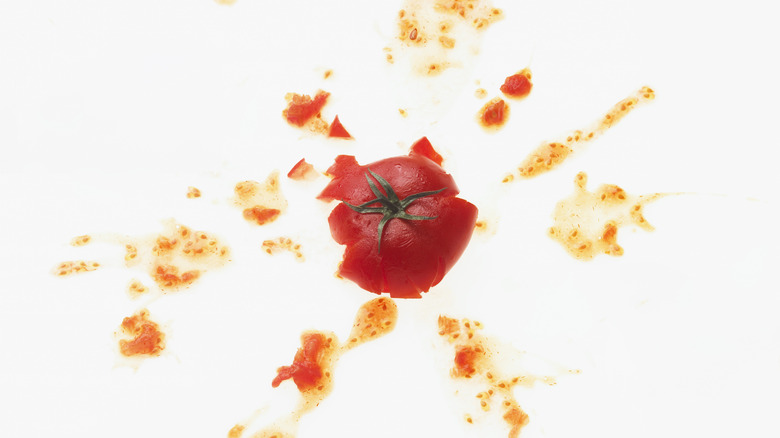13 Things You Didn't Know About Tomatoes
From a quick look at the world's dinner menus, it would be easy to believe that tomatoes were always a familiar and universally beloved comfort food. They're the showcase ingredient in many dishes from nearly every part of the world — from Mexican salsa to Italian marinara sauce to Middle Eastern shakshuka to Chinese tomatoes and scrambled eggs. And in the United States, what would any diner be without BLTs on the menu and a bottle of ketchup on the table?
For most of history, however, tomatoes were virtually unknown around the world. Native to South America, they were enjoyed by indigenous people who harvested the fruit of wild-growing tomato plants and eventually devised techniques for cultivating these plants to ensure a steady supply. It was only after Spanish explorers arrived in the New World in the 15th century and started bringing home samples of local plants that the rest of the world began to discover tomatoes. But it was far from love at first sight — Europeans didn't know what to make of the strange new fruit, and not all those brave enough to eat it liked what they found. So for most of the world's population, tomatoes were an acquired taste. Obviously, all that's changed. Let's take a look at 13 things you probably didn't know about tomatoes.
The first tomatoes enjoyed by humans were wild
When most of us think of tomatoes today, the first image that comes to mind is a fat, bright red orb about the size of a small orange. But tomatoes as we know them did not originally occur in nature. The wild ancestor of today's tomatoes, Solanum lycopersicum, was native to the coastal northwest regions of South America, from the Galapagos Islands up to Ecuador. And the fruit of the ancestral tomato plant was tiny — about the size of a cherry.
Plants with slightly larger fruit (about the size of today's cherry tomatoes) are now thought to have evolved naturally in Ecuador around 80,000 years ago, and people living in the region began to cultivate them for food. Over time, tomato plants spread northward into Central America and Mexico, where more people discovered and began to domesticate them. But not only did these early tomatoes look different from their modern-day descendants, they probably tasted quite different too. Experiments to cultivate a tastier tomato by crossbreeding a contemporary domestic tomato with a wild tomato resulted in fruit with an odd cucumber flavor, a feature of a chemical compound found in wild tomatoes, but long bred out of cultivated ones. And while cucumbers are tasty, no one wants a tomato that tastes like one — so that hybrid was rejected. Still, the experiment shed some interesting light on what it might have been like to eat tomatoes in ancient times.
Tomatoes are related to peppers and tobacco
If you visit a summer farmers market in certain parts of the world — such as the Mediterranean and Middle East — you're likely to see vegetables like eggplant, tomatoes, and peppers in conspicuous abundance. This will also explain why these veggies form the backbone of so many signature dishes from these regions, from dips to stews to sauces.
Experienced gardeners can tell you it's no coincidence these vegetables tend to appear together: They're all related — members of the nightshade family and collectively known as nightshade vegetables — and all thrive under similar growing conditions. They prefer hot, sunny climates and nutrient-rich soil – which is why many of us associate vine-ripe, fresh tomatoes with the height of summer (and in some cases, with that well informed gardening friend who can go on forever about soil pH levels and compost). The nightshade family is large and diverse — besides peppers and eggplant, tomatoes are also related to potatoes, petunias, and even tobacco.
The first tomatoes brought to Europe were yellow
Fans of heirloom tomatoes know that tomatoes come in colors other than red. And indeed, part of the fun of sourcing different heirloom varieties is trying to see how many shapes, sizes, and colors of tomatoes you can assemble in a single dish, from deep purple or orange to striped in multiple colors. To add to the intrigue, different colors can indicate different flavors: Tomatoes with darker colors are associated with more savory notes, yellow tomatoes are generally milder in flavor, while green ones are delicately flavored and tangy.
The earliest tomatoes (and the first to be introduced to diners outside South America) were thought to be not red but yellow. And the attractive, bright-yellow fruit made an impression on Europeans seeing tomatoes for the first time. In a letter to a friend in the early 1570s, Italian naturalist and physician Costanzo Felici described the exotic new fruit as a striking reddish yellow but noted it was "to my taste better to look at than to eat." Others introduced to tomatoes around this time found its yellow hue notable — the Italian word for tomato, pomodoro, translates literally as "apple of gold."
Europeans thought tomatoes were poisonous
It's natural, and often sensible, to approach unfamiliar objects with caution. While the first Europeans to encounter tomatoes were fascinated by them, they didn't fully trust them as a food source. Indeed, some upper-class diners actually did get sick after eating tomatoes — but only because the acid in the tomatoes leached out some of the lead from their eating utensils, resulting in lead poisoning that panicked diners mistook for tomato poisoning.
In addition, 15th century Europeans figured out that tomatoes were related to nightshade and mandrakes, plants not only known to be poisonous but believed to be active ingredients in the ointment made by witches to enable them to fly — or turn themselves into werewolves. This association added to the stigma already attached to tomatoes: If eating them didn't actually turn you into a werewolf, at the very least, it would make nosy neighbors suspect you were a witch. And even today, some eaters distrust tomatoes and other members of the nightshade family, claiming the alkaloids they contain can trigger inflammation. However, evidence for this is inconclusive, and some health professionals feel the nutritional benefits of tomatoes and related vegetables outweigh the risks.
Tomatoes were also considered aphrodisiacs
It was clear Europeans didn't quite know what to make of tomatoes when they first encountered them. While many concluded they were poisonous, others — especially in France — embraced them as an aphrodisiac, calling them pommes d'amour, or "apples of love." It's unclear exactly how tomatoes came to be considered aphrodisiacs, but theories abound. One theory is it's because tomatoes are related to mandrakes, which were also considered to have aphrodisiac properties. Another is that tomatoes resemble the human heart and thus became associated with love.
Even today, hopeful diners turn to tomatoes to enhance their love lives, and have at least some science backing them up. Tomatoes have high levels of potassium, which is thought to improve sexual performance in men. In addition, tomatoes have been associated with better muscle control, and their acids also stimulate blood flow to the mouth and lips. However, Pierce Howard, director of the Center for Applied Cognitive Studies in North Carolina, warns that no single food can guarantee a great romantic experience. Instead, as he told SFGate, you need to be both mentally present and physically fit. "What I advocate is that sexual performance is related to full alertness," he said. "That means no alcohol, not too much caffeine, no fats but plenty of complex carbohydrates and protein mixed with regular aerobic exercise."
An ornamental plant in Europe
When tomatoes made their first appearance in Europe, people there came to mixed conclusions about them, with some believing they contained deadly poisons while others celebrated them as aphrodisiacs. One thing both sides could agree on, however, was that fruiting tomato plants were cool to look at. Moreover, they grew easily in Spain and Italy, the countries where they made their first European appearance. For these reasons, tomatoes were initially cultivated and appreciated there as ornamental plants, rather than a source of food.
Tomatoes eventually spread from Mediterranean Europe to Great Britain, where their popularity as ornamental plants further reflected Europeans' conflicted fascination with them. While educated people knew they were eaten regularly and safely in their native South America, they still hesitated to try tomatoes themselves. In his book "The Tomato in America: Early History, Culture, and Cookery," Andrew F. Smith wrote, "John Parkinson the apothecary to King James I and botanist for King Charles I, proclaimed that while love apples were eaten by the people in the hot countries to 'coole and quench the heat and thirst of the hot stomaches,' British gardeners grew them only for curiosity and for the beauty of the fruit" (via Smithsonian Magazine).
The first European written recipe for tomato sauce dates to 1692
While Europeans were initially hesitant to eat tomatoes, a small number of adventurous cooks began experimenting with them as early as the 1580s. And the preparations they described would sound remarkably familiar to modern home cooks. A writer from this period, for example, described eating tomatoes with oil, salt, and pepper — an early version of tomato salad. Even earlier, following his travels to what is now Mexico in 1570, Spanish explorer and scientist Francisco Hernandez described "a delicious dip sauce from minced tomatoes, mixed with chili" — which sounds strikingly similar to the salsa served with tortilla chips at Mexican restaurants today.
The earliest recorded recipe for cooked tomato sauce dates to a cookbook published in Naples in 1692. The recipe, called "Spanish style" tomato sauce, called for roasted tomatoes to be skinned, minced, and blended with chopped onion, thyme, chile, salt, oil, and vinegar. Over time, similar recipes emerged that used black pepper instead of chiles and included garlic and parsley along with the other flavorings. It doesn't take much imagination to draw a line between these early culinary experiments and the familiar marinara sauce we enjoy today.
The tomato trek to North America
In America today, tomatoes play a starring role in iconic preparations from ketchup to Campbell's tomato soup to fried green tomatoes. But ironically, they had to take a long and circuitous route to get into American kitchens. Even though tomatoes are native to the New World, it took them longer to get to North America than to Europe: While they made their first appearance in Europe in the 1500s, when explorers to South America brought back seeds and plants they'd encountered, they didn't make it to the present-day United States until the early 1700s. The first written description of tomatoes in North America appears in a 1710 botany manual, which described tomatoes growing in the Carolinas.
It's not known, however, exactly how these tomatoes arrived in North America. One possibility is the plants were introduced by European settlers, who were already familiar with tomatoes and their cultivation. Another possibility is that enslaved people or others brought them from the Caribbean. In either case, they gradually spread across the country, first being cultivated in the South before making their way up the eastern seaboard, then westward.
North American diners didn't care for tomatoes
While 19th-century Americans found tomatoes easy to grow, they didn't find them easy to like as a food. Indeed, some found them downright vile. "Hardly two persons in a hundred, on first tasting it, thought that they would ever be induced to taste that sour trash a second time," Pennsylvania resident J.B. Garber wrote. Likewise, Philip R. Freas, editor of the Germantown Telegraph, called them "a very poor garden decoction, with a bad smell" (per The Washington Post). And in 1836, S.D. Wilcox, the editor of the Florida Agriculturalist, offered an especially melodramatic critique, calling the tomato "an arrant humbug and deserved forthwith to be consigned to the tomb of all the Capulets."
Just as picky children must be exposed to a food multiple times before accepting it, tomato-hating Americans, after repeated exposure to European tomato recipes appearing in cookbooks and newspapers, eventually came around and began to embrace the tomato. By 1824, tomatoes had already gained a solid foothold in the American kitchen, as evidenced by the 17 tomato recipes in "The Virginia House-Wife," a cookbook published that year. Throughout the 19th century, cooks became even more adventurous with tomatoes, coming up with creations such as tomato wine, which, according to the April 1859 edition of The Southern Planter, is "made with no other ingredients than the pure juice of the tomato and sugar, and very much resembles champagne — a light transparent color, with a pleasant, palatable flavor."
The biggest tomato-growing nation may surprise you
Tomatoes play a defining role in many of the world's cuisines — it's nearly impossible to imagine Italian, Mexican, or Spanish cooking without them. Historically, tomatoes became popular in countries such as Italy and Mexico because they grow easily in their warm climates. But as the rest of the world came to embrace tomatoes, farmers in other parts of the world saw opportunities to cultivate and sell them as well. Because of this, the largest tomato-producing country in the world is one where tomatoes play only a minor role in the national cuisine: China, which accounts for about a quarter of the tomatoes sold worldwide (the United States and India are the second and third largest tomato producers).
China's rise to dominance in the tomato market began in the 1990s. A private company began cultivating tomatoes in Xinjiang in 1993, joining the Xinjiang Production and Construction Corps of the Chinese army as a top Chinese tomato producer. Their business, however, wasn't driven by local demand (there was hardly any), but by the growing demand for tomatoes overseas. Almost all of China's tomatoes are processed into tomato paste and canned for sale in Africa and Europe — so don't expect to find locally grown heirloom tomatoes on the menu on your next trip to Beijing.
Tomatoes are great for cardiovascular health
Tomatoes are a fruit that cooks like a vegetable but eats like a guilty pleasure. They're a part of so many celebration foods — from salsa at your favorite Mexican restaurant to spaghetti sauce and Bloody Marys — it's easy to forget they're actually good for you (provided you enjoy the accompanying tortilla chips and vodka in moderation). Besides being virtually fat free (an 80-gram serving of raw tomatoes contains just 0.1 gram of fat), they're a good source of Vitamin C as well as carotenoids, compounds thought to offer multiple health benefits: They not only support eye health by protecting against macular degeneration, they help protect the skin from UV damage.
Tomatoes also offer a host of benefits for the cardiovascular system — which seems fitting for a fruit once valued for its resemblance to the human heart. They're a good source of potassium, a mineral that can reduce the risk of stroke and heart disease if regularly consumed. In addition, lycopene, the compound responsible for the red color of most tomatoes, is also thought to have protective properties against heart disease, as well as protective properties against certain cancer types, such as prostate and breast cancer.
The Spanish festival of La Tomatina
If you're among those who can never get enough tomatoes — and were also that kid who always got in trouble for playing with their food — you should make plans to be in Buñol, Spain the last Wednesday in August. This is when the town hosts La Tomatina, an officially sanctioned, hour-long food fight. At 11 a.m. on the day of La Tomatina, trucks full of ripe tomatoes arrive at the town's central square. When water cannons are shot off, the fun officially begins: Participants grab the tomatoes and hurl them at each other. That's it. No strategy, no scorekeeping — just lots and lots of squished tomatoes and happy, dripping people. When the battle ends an hour later, the streets are hosed down (and end up even cleaner than before, a benefit of all the acid in the tomatoes), and participants jump into a nearby river to wash off.
La Tomatina started by accident — during another, more formal parade in the 1940s, a group of youth knocked off part of the costume of a parade participant, who threw a tantrum and knocked over a tomato stall. For some reason, this moved parade spectators to start throwing the tomatoes at each other. Realizing this was more fun than a standard parade, they organized an official tomato fight the following year — and a tradition was born!
No, audiences didn't throw rotten tomatoes at the Globe Theatre
While tomatoes were once appreciated as an ornamental plant, the most common (though false) non-culinary use for them that comes to mind is throwing them at incompetent stage performers — the film review site Rotten Tomatoes is a clear example of a link between tomato-throwing and less-than-nuanced theater criticism. And it's easy to see why hostile theater-goers made tomatoes their weapon of choice: They're lightweight, fit easily in the hand, and hit their victims with a satisfyingly messy splat.
But contrary to popular belief, there was no tomato-throwing at the famed Globe Theatre in London, where Shakespeare staged his plays. During Shakespeare's time – the Globe Theatre was built in 1599 – tomatoes were still little known in Great Britain, and were unlikely to have been available to most audience members (the first English-language recipe for tomatoes didn't appear until 1752). Shakespearian audiences, however, were known to be a boisterous bunch, and in their era, loudly clapping and booing at stage performers was expected and accepted, and fights among the audience were occasionally documented. So while it's possible that at least one performer got something thrown at them, we can be sure it wasn't a tomato.

